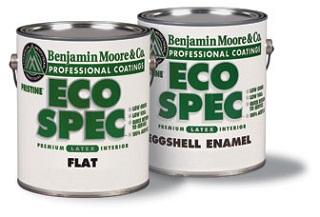From Guest Blogger Lillian Connors: An Introduction to Earth-Friendly Metal Paint

Why is Conventional Paint Bad?
Before we get into the details about eco-friendly paint, let’s shed some light on the problems surrounding the conventional paint. Have you ever noticed that you get slightly dizzy, nauseous or your head starts to hurt when you inhale paint fumes while trying to spruce up your bedroom or renew the kitchen paintjob? These symptoms come as no coincidence, and they could have some long-term effects.
Traditional paints constitute of chemical compounds such as formaldehyde, heavy metals and volatile organic compounds, also known as VOCs. These compounds are hazardous both for the environment as well as people, especially if reaches our lungs, enters the water supplies or starts leaking into the soil.
Further, people – like professional decorators and home painters – who are regularly exposed to conventional paints have a 40% higher chance of developing lung cancer. Having that in mind, it comes as no surprise that traditional paint is detrimental to the health of anyone surrounded by it, which can be seen in the number of allergic reactions and asthma attacks.
Additionally, the process of paint production is hazardous to the Earth, resulting in 30 l of toxic waste generated for every liter of paint made. Bear in mind that this is the petrochemical industry which uses unsustainable resources that damage the Earth and contribute greatly to the emission of greenhouse gasses, further aggravating the problem of global warming.
How Can Eco-Paint Save the Day?
While anything truly eco-friendly is very difficult to find, one thing is for sure – eco paints have less chemical compounds than traditional paints or they might be completely free of them. There is no clearly drawn line that separates the requirements for ecological paints and traditional paints, but the way they are manufactured can be very different so make sure to read the label carefully. Ecological paints can be derived from sustainable, ethical sources and can contain raw ingredients based on organic materials.
Probably one of the best aspects of ecological paint production is that it comes from environmentally friendly sources and that the waste produced during manufacturing is turned into compost. So, whether you are painting the inside of your house or you’re working on renewing metal surfaces like fences and security bars, be sure to find a lasting eco-friendly paint that will preserve the material, making it shiny and vibrant.
How to Use Ecological Paint
Let’s say that you need to re-paint your garage door. What you want to do is use eco metal paint, and follow the process that comes before its application. You cannot simply add paint to a corroded surface.
First of all, you will need to determine what type of metal you are trying to paint. For instance, ferrous metals are susceptible to rust and deterioration while galvanized metals are treated against rust, but both have their specific needs when it comes to painting. When painting ferrous metals, you will need to remove any and all rust from the surface and prime it for painting, while galvanized metal has an oily coating that you have to wash off in order to allow for the paint to adhere.
Additionally, there are various items made of metal that require a unique approach. Wrought iron patio furniture is typically exposed to the outdoor elements and it should be painted with quality metal paint that provides furniture with much-needed protection, in addition to being safe for the environment.
Eco-paint is not easy to come by as the market is completely dominated by conventional paint manufacturers, so your best chances of finding the product you need is by going online. There you can find special deals and search for paints that will fit your ethical standards, and you will be able to paint to your heart’s content without exposing yourself or the environment to any danger.

When I started to focus on green building I switched to low VOC paints in 2003 and all my workers liked the reduced odor and the clients who noticed thought that the extra cost was well worth the price. At the time it cost $5 more a gallon for Eco Spec. Now many companies have switched to zero VOC paints with little or no publicity. At a pro day a few years ago I found out that all Val Spar latex paints (available at Lowes) are zero VOC.
For painting steel or iron I always use a rust reformer on bare rusted metal. It chemically changes rust so that it does not rust anymore.